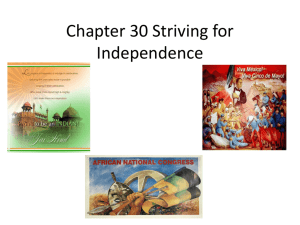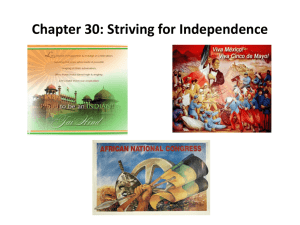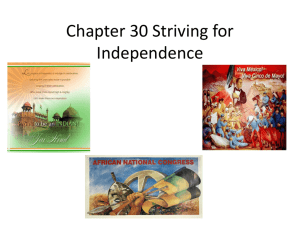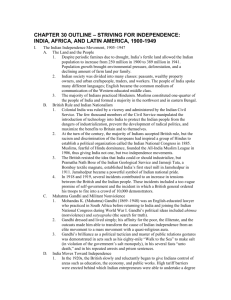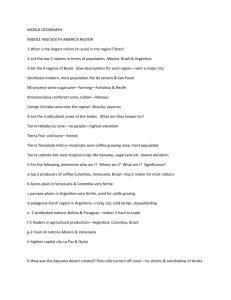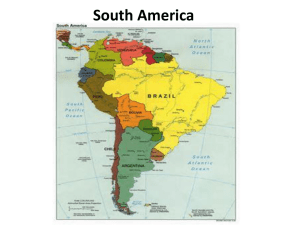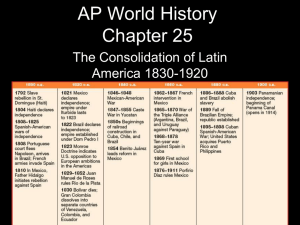CHAPTER 31
advertisement
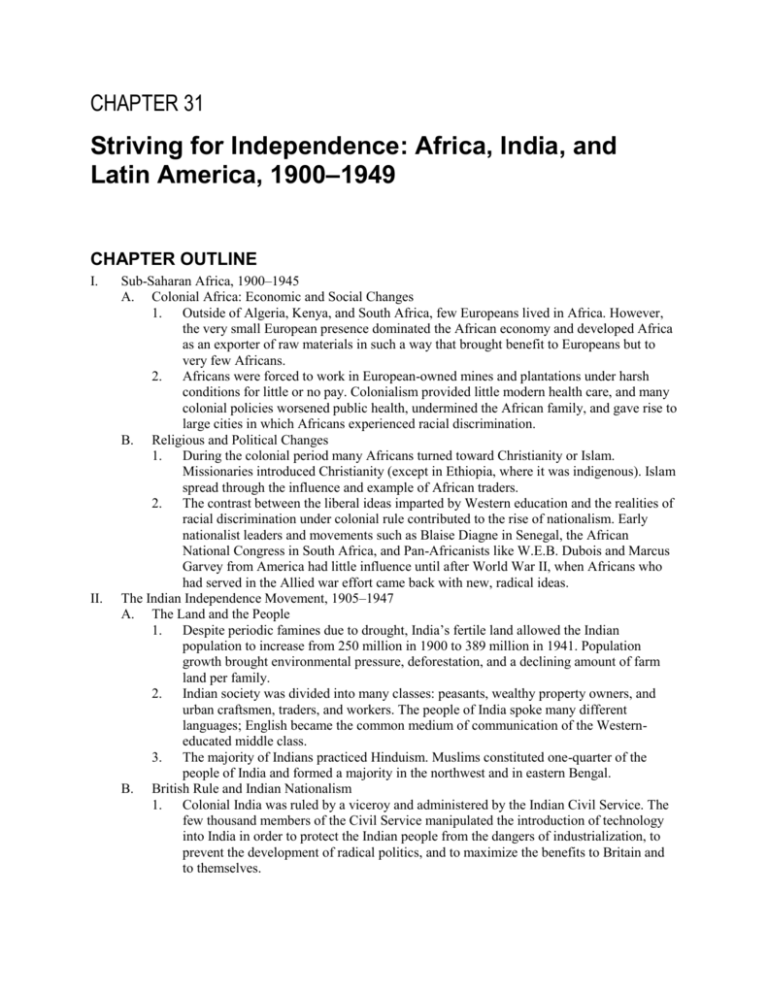
CHAPTER 31 Striving for Independence: Africa, India, and Latin America, 1900–1949 CHAPTER OUTLINE I. II. Sub-Saharan Africa, 1900–1945 A. Colonial Africa: Economic and Social Changes 1. Outside of Algeria, Kenya, and South Africa, few Europeans lived in Africa. However, the very small European presence dominated the African economy and developed Africa as an exporter of raw materials in such a way that brought benefit to Europeans but to very few Africans. 2. Africans were forced to work in European-owned mines and plantations under harsh conditions for little or no pay. Colonialism provided little modern health care, and many colonial policies worsened public health, undermined the African family, and gave rise to large cities in which Africans experienced racial discrimination. B. Religious and Political Changes 1. During the colonial period many Africans turned toward Christianity or Islam. Missionaries introduced Christianity (except in Ethiopia, where it was indigenous). Islam spread through the influence and example of African traders. 2. The contrast between the liberal ideas imparted by Western education and the realities of racial discrimination under colonial rule contributed to the rise of nationalism. Early nationalist leaders and movements such as Blaise Diagne in Senegal, the African National Congress in South Africa, and Pan-Africanists like W.E.B. Dubois and Marcus Garvey from America had little influence until after World War II, when Africans who had served in the Allied war effort came back with new, radical ideas. The Indian Independence Movement, 1905–1947 A. The Land and the People 1. Despite periodic famines due to drought, India’s fertile land allowed the Indian population to increase from 250 million in 1900 to 389 million in 1941. Population growth brought environmental pressure, deforestation, and a declining amount of farm land per family. 2. Indian society was divided into many classes: peasants, wealthy property owners, and urban craftsmen, traders, and workers. The people of India spoke many different languages; English became the common medium of communication of the Westerneducated middle class. 3. The majority of Indians practiced Hinduism. Muslims constituted one-quarter of the people of India and formed a majority in the northwest and in eastern Bengal. B. British Rule and Indian Nationalism 1. Colonial India was ruled by a viceroy and administered by the Indian Civil Service. The few thousand members of the Civil Service manipulated the introduction of technology into India in order to protect the Indian people from the dangers of industrialization, to prevent the development of radical politics, and to maximize the benefits to Britain and to themselves. 2. At the turn of the century, the majority of Indians accepted British rule, but the racism and discrimination of the Europeans had inspired a group of Hindus to establish a political organization called the Indian National Congress in 1885. Muslims, fearful of Hindu dominance, founded the All-India Muslim League in 1906, thus giving India not one, but two independence movements. 3. The British resisted the idea that India could or should industrialize, but Pramatha Nath Bose of the Indian Geological Service and Jamseji Tata, a Bombay textile magnate, established India’s first steel mill in Jamshedpur in 1911. Jamshedpur became a powerful symbol of Indian national pride. 4. In 1918 and 1919 several incidents contributed to an increase in tensions between the British and the Indian people. These incidents included a too-vague promise of selfgovernment, the influenza epidemic of 1918–1919, and the incident in which a British general ordered his troops to fire into a crowd of 10,000 demonstrators. C. Mahatma Gandhi and Militant Nonviolence 1. Mohandas K. (Mahatma) Gandhi (1869–1948) was an English-educated lawyer who practiced in South Africa before returning to India and joining the Indian National Congress during World War I. Gandhi’s political ideas included ahimsa (nonviolence) and satyagraha (the search for truth). 2. Gandhi dressed and lived simply; his affinity for the poor, the illiterate, and the outcasts made him able to transform the cause of Indian independence from an elite movement to a mass movement with a quasi-religious aura. 3. Gandhi’s brilliance as a political tactician and master of public relations gestures was demonstrated in acts such as his eighty mile “Walk to the Sea” to make salt (in violation of the government’s salt monopoly), in his several fasts “unto death,” and in his repeated arrests and prison sentences. D. India Moves Toward Independence 1. In the 1920s the British slowly and reluctantly began to give Indians control of areas such as education, the economy, and public works. High tariff barriers were erected behind which Indian entrepreneurs were able to undertake a degree of industrialization; this helped to create a class of wealthy Indian businessmen who looked to Gandhi’s designated successor in the Indian National Congress–Jawaharlal Nehru (1889–1964)– for leadership. 2. The Second World War divided the Indian people; Indians contributed heavily to the war effort, but the Indian National Congress opposed the war, and a minority of Indians joined the Japanese side. E. Partition and Independence 1. In 1940 the Muslim League’s leader Muhammad Ali Jinnah (1876–1948) demanded that Muslims be given a country of their own, to be named Pakistan. When World War II ended, Britain’s new Labour Party government prepared for independence, but mutual animosity between the Indian National Congress and the Muslim League led to the partition of India into two states: India and Pakistan. 2. Partition and independence were accompanied by violence between Muslims and Hindus and by massive flows of refugees as Hindus left predominantly Muslim areas and Muslims left predominantly Hindu areas. III. The Mexican Revolution, 1910–1940 A. Mexico in 1910 1. Mexico’s geographical location made it subject to numerous foreign invasions and interventions. Upon independence in 1821 Mexican society was deeply divided; a few wealthy families of Spanish origin owned 85 percent of the land, while the majority of Indians and mestizos were poor peasants. 2. Concentration of land ownership increased after independence as wealthy families and American companies used bribery and force to acquire millions of acres of good agricultural land in southern Mexico, forcing peasants into wage labor, debt, and relocation. In northern Mexico, American purchase of land, the harsh living conditions, and the unequal distribution of wealth also caused popular resentment. 3. In 1910 General Porfirio Diaz (1830–1915) had ruled for thirty-four years. Diaz’s policies had made Mexico City a modernized showplace and brought wealth to a small number of businessmen, but his rule was also characterized by discrimination against the nonwhite majority of Mexicans and a decline in the average Mexican’s standard of living. B. Revolution and Civil War, 1911–1920 1. The Mexican Revolution was not the work of one party with a well-defined ideology; it developed haphazardly, led by a series of ambitious but limited men, each representing a different segment of Mexican society. 2. Francisco I Madero (1873–1913) overthrew Diaz in 1911, only to be overthrown in turn by General Victoriana Huerta in 1913. The Constitutionalists Venustiano Carranza and Alvaro Obregon emerged as leaders of the disaffected middle class and industrial workers and they organized armies that overthrew Huerta in 1914. 3. Emiliano Zapata (1879–1919) led a peasant revolt in Morelos, south of Mexico City, while Francisco (Pancho) Villa organized an army in northern Mexico. Neither man was able to rise above his regional and peasant origins to lead a national revolution; Zapata was defeated and killed by the Constitutionalists in 1919, and Villa was assassinated in 1923. 4. The Constitutionalists took over Mexico after years of fighting, an estimated 2 million casualties, and tremendous damage. In the process, the Constitutionalists adopted many of their rivals’ agrarian reforms and proposed a number of social programs designed to appeal to workers and the middle class. C. The Revolution Institutionalized, 1920–1940 1. The Mexican Revolution lost momentum in the 1920s, but it had given representatives of rural communities, unionized workers, and public employees a voice in government. 2. After President Obregon’s assassination in 1928 his successor Plutarco Elias Calles founded the National Revolutionary Party, which was renamed the Mexican Revolutionary Party (PRM) by President Lazaro Cardenas in 1934. Cardenas removed generals from government, redistributed land, replaced church-run schools with government schools, and expropriated the foreign-owned oil companies that had dominated Mexico’s petroleum industry. 3. When Cardenas’s term ended in 1940 Mexico was still a land of poor farmers with a small industrial base. Nonetheless, the Mexican Revolution had established a stable political system, tamed the military and the Catholic Church, and laid the foundations for the later industrialization of Mexico. IV. Argentina and Brazil, 1900–1949 A. The Transformation of Argentina 1. At the end of the nineteenth century the introduction of railroads and refrigerator ships transformed Argentina from an exporter of hides and wool to an exporter of meat. The introduction of Lincoln sheep and Hereford cattle for meat production led Argentine farmers to fence, plow, and cultivate the pampas, transforming pampas into farmland which, like the North American Midwest, became one of the world’s great producers of meat and wheat. 2. Argentina’s government represented the interests of the oligarquia, a small group of wealthy landowners. This elite had little interest in anything other than farming; they were content to let foreign companies, mainly British, build the railroads, processing B. C. D. E. plants, and public utilities, while Argentina exported agricultural goods and imported almost all its manufactured goods. Brazil and Argentina, to 1929 1. Brazil’s elite of coffee and cacao planters and rubber exporters resembled the Argentine elite: they used their wealth to support a lavish lifestyle, allowed the British to build railroads, harbors, and other infrastructure, and imported all manufactured goods. Both Argentina and Brazil had small but outspoken middle classes that demanded a share in government and looked to Europe as a model. 2. The disruption of European industry and world trade in World War I weakened the landowning classes in Argentina and Brazil so that the urban middle class and the wealthy landowners shared power at the expense of the landless peasants and urban workers. 3. During the 1920s peace and high prices for agricultural exports allowed both Argentina and Brazil to industrialize, but the introduction of new technologies left them again dependent on the advanced industrial countries. Aviation and radio communications were introduced to Argentina and Brazil during the 1920s, but European and United States’ companies dominated both sectors. The Depression and the Vargas Regime in Brazil 1. The Depression hit Latin America very hard and marks a significant turning point for the region. As the value of their exports plummeted and their economies collapsed, Argentina and Brazil, like many European countries, turned to authoritarian regimes that promised to solve their economic problems. 2. In Brazil Getulio Vargas (1883–1953) staged a coup and practiced a policy called import substitution industrialization. Increased import duties and promotion of national firms and state-owned enterprises brought industrialization and all of the usual environmental consequences: mines, urbanization, slums, the conversion of scrubland to pasture, and deforestation. 3. Vargas instituted reforms that were beneficial to urban workers, but because he did nothing to help the landless peasants, the benefits of the economic recovery were unequally distributed. In 1938 Vargas staged a second coup, abolished the constitution, made Brazil a fascist state, and thus infected not only Brazil but also all of South America with the temptations of political violence. He himself was overthrown in a military coup in 1954. Argentina After 1930 1. Economically, the Depression hurt Argentina almost as badly as it did Brazil, but the political consequences were delayed for years. In 1930 General Jose Uriburu overthrew the popularly elected president and initiated thirteen years of rule by generals and the oligarquia. 2. In 1943 Colonel Juan Peron (1895–1974) led another coup and established a government that modeled itself on Germany’s Nazi regime. As World War II turned against the Nazis, Peron and his wife Eva Duarte Peron appealed to urban workers to create a new base of support that allowed Peron to win the presidency in 1946 and to establish a populist dictatorship. 3. Peron’s government sponsored rapid industrialization and spent lavishly on social welfare projects, depleting capital that Argentina had earned during the war. Peron was unable to create a stable government, and soon after his wife died in 1952 he was overthrown in a military coup. Mexico, Argentina, and Brazil: a Comparison 1. Until 1910 Mexico, Argentina, and Brazil shared a common history and similar cultures. In the first half of the twentieth century their economies followed parallel trajectories, but their political histories diverged radically. 2. Mexico underwent a traumatic and profound social revolution. Argentina and Brazil remained under the leadership of conservative regimes that were devoted to the interests of the wealthy landowners and which were periodically overturned by military coups and populist demagogues.

